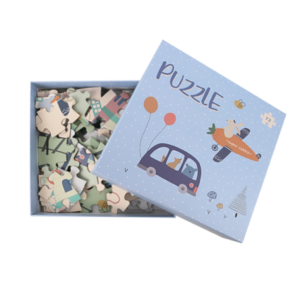a good-old wooden puzzle for toddlers has as much STEM-boosting potential as any of them. “It’s equally educational to bang two knob-shaped puzzle pieces together like cymbals, make up a story in which the puzzle piece mama and baby giraffe get lost, or stack the puzzle pieces into a tower,” says child development expert Julia Luckenbill, who is the infant-toddler program coordinator at the Center for Child and Family Studies at UC Davis. “This is particularly important because adults tend to see one right way to use materials, while children are more dynamic in the way they think.” The best puzzles for babies and toddlers build foundational skills and segue perfectly into more complex puzzles for older kids. In their older years, similar games can help build Key STEM concepts, including abstract thinking, logical reasoning, problem-solving, spatial reasoning, and math.
To get the most out of baby puzzles, parents should be as hands-off as possible and let children, be it, babies, toddlers, and older kids, work them out on their own, taking whichever approach suits them and making the problem-solving process as open-ended as possible. Babies love putting things in and taking them out, so we chose puzzles that let them do just that, while also allowing them to practice their fine motor skills and hand-eye coordination. With toddlers, who can fit pieces into the right spot, the puzzles are somewhat more complex, and encourage them to develop their shape and color recognition skills, and as well as their spatial skills. Plus, they can use any puzzle for pretend play. As for older kids, it’s brain-twisters, logic puzzles, and other dope STEM toys.
The Best Puzzle Games for Kids
Remember the old, beloved
A jigsaw puzzle is a tiling puzzle that requires the assembly of often oddly shaped interlocking and mosaiced pieces, each of which typically has a portion of a picture; when assembled, they produce a complete picture.
In the 18th century, jigsaw puzzles were created by painting a picture on a flat, rectangular piece of wood, then cutting it into small pieces. Despite the name, a jigsaw was never used. John Spilsbury, a London cartographer and engraver, is credited with commercialising jigsaw puzzles around 1760.[1] They have since come to be made primarily of cardboard.
Typical images on jigsaw puzzles include scenes from nature, buildings, and repetitive designs—castles and mountains are common, as well as other traditional subjects. However, any picture can be used. Artisan puzzle-makers and companies using technologies for one-off and small print-run puzzles utilize a wide range of subject matter, including optical illusions, unusual art, and personal photographs. In addition to traditional flat, two-dimensional puzzles, three-dimensional puzzles have entered large-scale production, including spherical puzzles and architectural recreations.
A range of jigsaw puzzle accessories including boards, cases, frames, and roll-up mats has become available to assist jigsaw puzzle enthusiasts. While most assembled puzzles are disassembled for reuse, they can also be attached to a backing with adhesive and displayed as art.
And it makes kids’ brains work. It’s a great puzzle for 3-year-olds.


